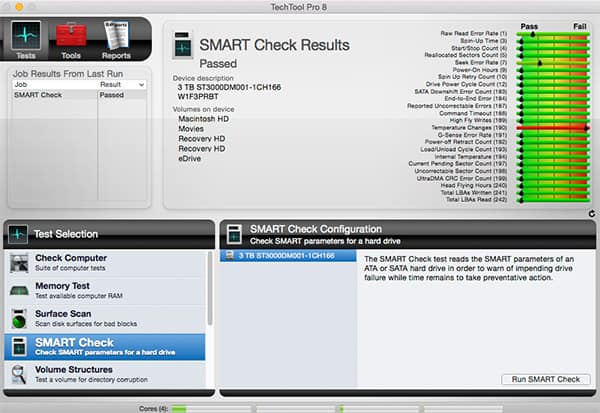
Above: TechTool Pro has always tried to make the work of fixing a sick Mac look interesting. Photo courtesy Micromat.
BitDepth#1019 for December 15, 2015
All my Windows and Linux readers are going to feel a little left out here, but you might want to hold on to this column should a Mac-toting friend or relative beg for help when things go dark and multilingual.
Confession time. Around 12 years, ago I flirted with fixing Macs as a serious sideline. I had a partner I could work with, a few loyal clients and even a name and a logo for MacMedics.
I’d been messing around with getting Apple’s computers back up and running for almost a decade by then, starting with my own issues with a range of their models as I upgraded systems in the good old days of Norton Utilities and MacTools, and then out of an intense curiosity with how the computers worked, particularly the software.
By the time 2004 rolled around, a few things became pretty clear to me.
First, it was obvious that Apple was committed to locking down their computers even more tightly than before.
At least part of the reason for that is that MacOSX, despite its graphical opulence, is only a shell that runs on top of an industrial strength Unix engine and that system isn’t one that casual users should mess around with.
The other was the growing realisation that Macs, not the most modular computers ever made, were slowly becoming tightly integrated systems which did not welcome hands-on meddling.
In 2015, both predictions are in full bloom. Even professionals trained by Apple have few options when it comes to repairing the hardware.
The MacBook Pro I bought in 2008 began exhibiting some problems and in its first year had its top tray, screen and motherboard replaced under warranty. That left me with the original hard drive, RAM, optical drive and a sheet of aluminum described as the bottom tray that’s basically a shallow and quite empty baking dish.
Today, fixing a wonky Mac consists of just four tiers of activity.
One. Restart. Really. Most problems with Mac system software gets tidied up by the OS itself when the system is rebooted. Since most people use MacBooks of one kind or another, there’s rarely any need to restart them, so this doesn’t get done as often as it used to.
Two. Run Disk First Aid. You’ll find this option in Disk Utility, a formatting tool that’s included with the OS which includes a system diagnostic function.
Some problems are better handled without the shell of the MacOS running, so on startup, hold down the Command and S keys. This will dump you into Unix Single User mode, which can be either frightening or utterly cool, depending on which side of the appreciating scrolling white text on a black background side of things you fall on.
Once the scrolling is done, type FSCK -yf exactly. That triggers a deeper version of Disk First Aid called file system consistency check that clears up most system level issues (the f forces a check and the y automatically repairs anything it finds). If you get “FILE SYSTEM WAS MODIFIED” after it’s done, run it again.
Three. Boot into recovery mode (hold down Command-R on startup). Recent versions of the MacOS set aside a small partition on your startup disk for a recovery partition which has a small version of the OS and Disk Utility.
Four. If that brings you no joy, you may want to try a third party system repair tool. A good all-round solution is TechTool Pro; another is Disk Warrior. If you have more than three Macs in your house, it’s probably a good idea to own one along with a good data recovery tool (I use Data Rescue).
Both include a tool which allows you to create a bootable flashdrive using the recovery partition’s software. Repairs on a drive are always more efficient when run from another drive entirely.
Most problems with Macs tend to be directory errors. The directory is a database of what bits are stored where on your hard drive. Problems with it lead to all kinds of crazy errors.
I own both repair tools, and while TechTool Pro is capable and much prettier, Disk Warrior, which specialises in directory optimisation and replacement, is the particularly robust at sorting out directory problems and spotting pending disk failure.
Some problems have nothing to do with software and when that happens, it’s a really good idea to have Apple’s extended warranty active.
Most Mac systems either give trouble in the first three years or end up being pretty much invincible, so it’s a good investment, particularly for a portable computer.
Unfortunately, the days when a layman could open a Mac and actually fix anything are pretty much behind us. Motherboards are the size of a chocolate bar (most of the space in a MacBook is taken up with batteries) and RAM is hard soldered to it.
So there’s only so much you can do before turning a Mac over to a qualified technician for repair and now you know what those steps are.


